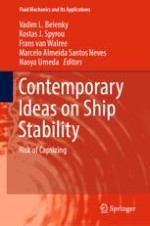2019 | OriginalPaper | Buchkapitel
12. Calculation Method to Include Water on Deck Effects
verfasst von : Nicolas F. A. J. Carette, Frans van Walree
Erschienen in: Contemporary Ideas on Ship Stability
Aktivieren Sie unsere intelligente Suche, um passende Fachinhalte oder Patente zu finden.
Wählen Sie Textabschnitte aus um mit Künstlicher Intelligenz passenden Patente zu finden. powered by
Markieren Sie Textabschnitte, um KI-gestützt weitere passende Inhalte zu finden. powered by
